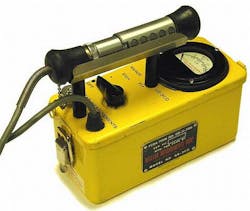Military radiation-detector market to grow to $868 million by 2022, analysts predict
Demand for radiation-detection devices in domestic security applications, meanwhile, will grow from $1.35 billion currently to $1.92 billion by 2022, analysts say in the report "Radiation Detection In Domestic Security and Military Markets, 2015-2022.
The military and security sectors are two of the fastest-expanding areas for radiation detection and attracting heavy investments, analysts say. The bulk of radiation detection demand is centered in health care and medical applications, but those markets also represent the sector's slowest growth rates.
One factor driving growth in the military and domestic security radiation-detect markets is the supposed increase in terrorist activity, and a need for radiation monitoring and control to help in confiscating illicit radioactive materials, maintaining tabs on emitted rays from known sources, and measuring radiation in the aftermath of terrorist activities, analysts say.
Related: DARPA asks industry to develop pocket-sized radiation detectors to foil nuclear terrorism
Demand for radiation detectors in ports of entry like airports is enormous, analysts say. Between backscattering and millimeter-wave technologies, the latter seems to have a leg up these days due to privacy questions.
Fixed portal monitors, especially docked at airports for passenger scrutiny, also need to establish that they don’t release any ionizing radiation themselves.
Demand for radiation detectors for first responders also is very high, analysts say, as these technologies have applicability in public areas to prevent release of radiation leading to damage and injury. Device designs that offer more powerful capabilities while emphasizing ease-of-use are proliferating -- including development of mobile applications.
Portability and easy of use will govern radiation detector design. Handheld RIDs and personal dosimeters will have strong market growth since they can be carried in the field. Portable devices also are being networked together.
With ever-tightening control over Helium-3 (meaning high prices and low availability), look for more activity in new scintillating materials, especially CLYC. Plastic scintillators are gaining attention as an option for detectors -- including one example of a newly fabricated prototype device said to be extensible to larger volumes, analysts say.
The report explores the revenue potential for military and domestic security radiation detection, from personal radiation detection to fixed installations in aircraft and surface ships. The report also looks into the products and marketing strategies of the leading suppliers of radiation detection equipment.
This report includes granular eight-year forecasts in volume and value, and breaks results out by device types and world region.
Companies discussed in this report include: Arrow-Tech, Baltic Scientific, Berkeley Nucleonics Corporation, Bruker, Bubble Technology, Canberra, FLIR, L-3 Communications, Leidos, Ludlam Measurements, Mirion, North American Technical Services, Nuctech, Radiation Monitoring Devices (Dynasil), Rapiscan, Safran/Morpho, Saphymo, Smiths Group, and Thermo Fisher Scientific.
For more information contact NanoMarkets online at www.nanomarkets.net.
